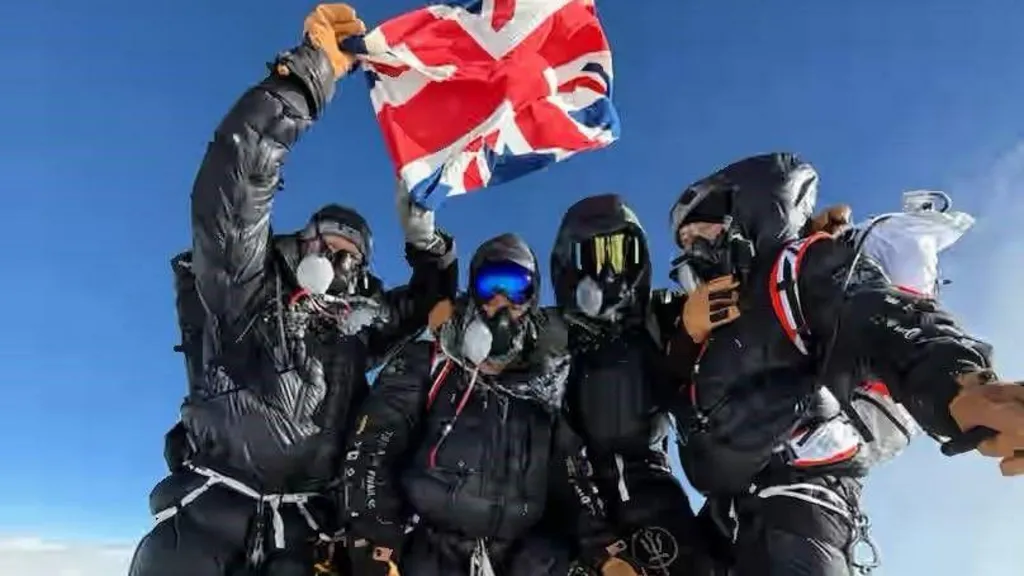No Acclimatization, No Problem? Brits Redefine Everest Climb
Mount Everest has once again made headlines – this time not for a fastest ascent, but for one of the most unconventional. Four British former special forces soldiers, including UK Veterans Minister Alastair Carns, have successfully summited the world’s highest peak in just under five days – without any acclimatisation on the mountain itself.
The climb, completed on May 21st, marks a record-setting ascent for a team bypassing the traditional weeks-long acclimatisation process in the Himalayas. Instead, the group relied on months of simulated altitude training and a controversial method: inhaling xenon gas.

Four British climbers pose on the summit of Mount Everest less than a week after leaving London, in one of the fastest ascents on record of the world’s highest peak, in Nepal (Sandro Gromen via AP)
Table of contents
Rewriting the Rules of Acclimatization?
The Ripple Effects: Ethics, Tourism, and Certification
Building Stamina and Endurance for Alpine Climbing
Not the Fastest Ever, But a Historic First
Rewriting the Rules of Acclimatization?
The four climbers spent six weeks sleeping in hypoxic tents at home, simulating high-altitude conditions by reducing oxygen levels using specialized equipment. Then, just two weeks before heading to Nepal, they inhaled xenon gas at a clinic in Germany – reportedly to stimulate red blood cell production and help the body adapt to thin air.
Upon arrival in Nepal, they flew straight to Everest Base Camp and began the climb immediately, accompanied by five Sherpa guides and a cameraman. They used supplemental oxygen like most high-altitude climbers but skipped the usual acclimatisation rotations between camps.
“They started on the afternoon of 16 May and summited on the morning of 21 May – taking four days and approximately 18 hours,” said expedition organiser Lukas Furtenbach, who has pioneered pre-acclimatisation techniques in the past.
Mountaineering World Divided
While the achievement is undeniably impressive, many in the climbing community are raising red flags about the method.
Experts argue that acclimatisation is not just about red blood cell count, but a complex physiological process involving the brain, lungs, heart, and kidneys – something no single drug or gas can shortcut. The International Climbing and Mountaineering Federation has warned in statement in January:
“According to current literature, there is no evidence that breathing in xenon improves performance in the mountains, and inappropriate use can be dangerous…. Acclimatization to altitude is a complex process that affects the various organs/systems such as the brain, lungs, heart, kidneys and blood to different degrees, and is not fully understood.…”
Veteran guide Adrian Ballinger, who also uses hypoxic tents with clients, expressed concern about promoting xenon as a performance enhancer:
“People are grasping at shortcuts instead of doing the real work of acclimatisation and training.”
The Ripple Effects: Ethics, Tourism, and Certification
This method could potentially redefine how Everest is climbed – but not without consequences. Industry leaders worry that faster expeditions may reduce climber stays in Nepal, directly impacting local tourism.
“If climbers stop acclimatising in the mountains, the length of their stay drops significantly,” warned Damber Parajuli , president of the Expedition Operators Association of Nepal. “This would not only hurt the economy but also breaks the fundamental principles of mountaineering. Authorities should reconsider certifying such climbs.” he told the BBC.
Nepal’s tourism officials said they were unaware the British team had skipped acclimatization and may now re-evaluate regulations for future expeditions. But Furtenbach defends the method, citing lower ecological impact and reduced health risk due to less time spent in high-risk zones like the Death Zone (above 8,000m).

Photo: Lucas Furtenbac
Not the Fastest Ever, But a Historic First
While this expedition is the fastest recorded Everest ascent without acclimatization in the Himalayas, it does not break the overall Everest speed record. That title still belongs to Lhakpa Gelu Sherpa, who reached the summit from base camp in just 10 hours and 56 minutes in 2003 – but only after weeks of on-mountain acclimatization.
What this British team has done is redefine what’s possible with modern technology and extreme preparation – and in doing so, they may have opened a new chapter in Himalayan climbing.
So, finally, What do you think, does Everest need a new rulebook? Or is this the future of high-altitude climbing? Share your thoughts in the comments.





Comments
Deprecated: File Theme without comments.php is deprecated since version 3.0.0 with no alternative available. Please include a comments.php template in your theme. in /www/summiters_241/public/wp-includes/functions.php on line 6121